Is your kitchen putting you to sleep? Feeling trapped in a world of stainless steel and granite? It’s time to shake things up with nature’s own décor that ACTUALLY works for you!
Let’s face it – your kitchen isn’t just where you heat up last night’s pizza. It’s your morning coffee spot, your midnight snack headquarters, and sometimes your impromptu dance floor. So why does it look so… boring?
Here’s the game-changer: plants aren’t just pretty faces! They’re working overtime to clean your air, boost your mood, AND they can flavor your food. Triple threat? We think YES!
Ready for the ultimate kitchen glow-up? Grab your coffee and keep scrolling – these 15 jaw-dropping ideas will make your friends wonder when you hired a professional designer (spoiler: you didn’t!).
1. Indoor Herb Garden Kitchen – Your Personal Farmers Market is OPEN!
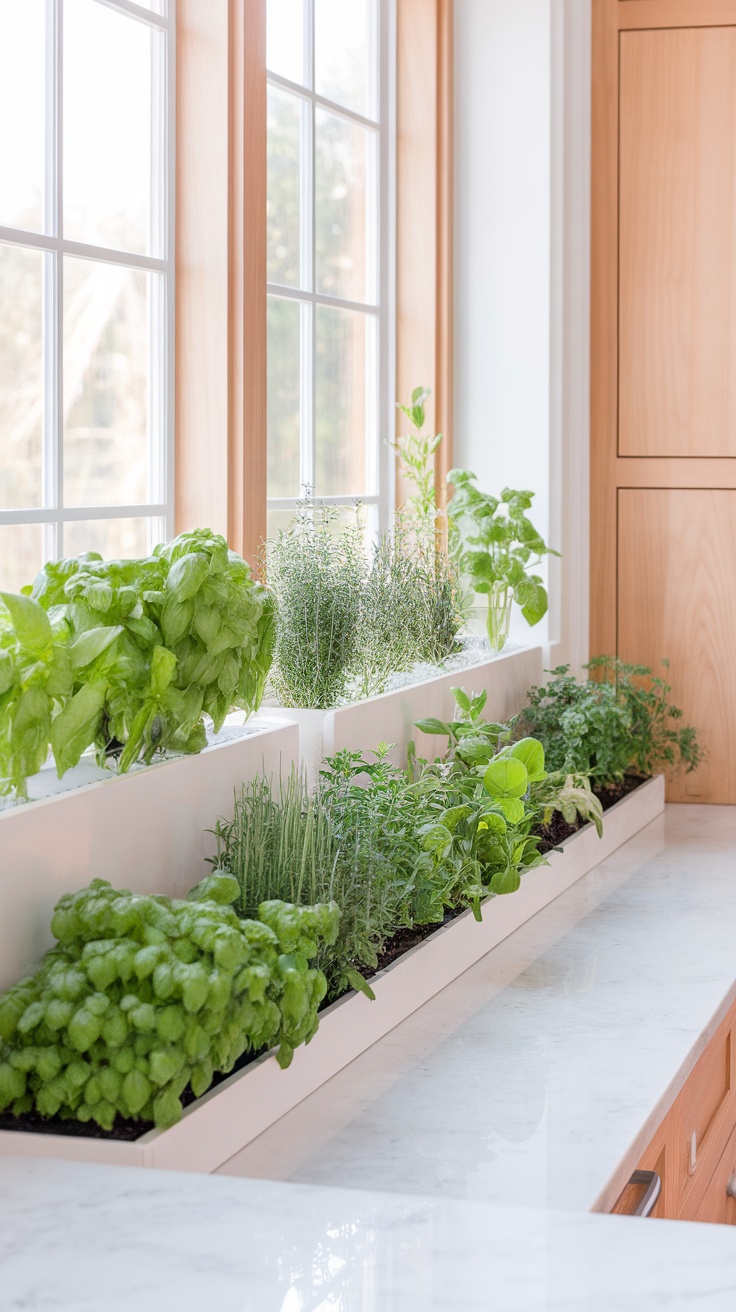
Stop throwing money at wilted grocery store herbs that die in your fridge! This kitchen windowsill situation is basically your own personal 24/7 flavor station where the ingredients are ALWAYS fresh!
Look at that sunny window working overtime as nature’s grow light! That rustic wooden planter isn’t just cute – it’s the perfect contrast against that fancy marble countertop, proving that country charm and luxury can TOTALLY hang together.
With basil, chives, and parsley all living their best lives just inches from your cooking space, you’re basically a farm-to-table restaurant now. Need a sprinkle of fresh herbs? Just reach over and snip! Instant flavor upgrade without the $4.99 plastic clamshell package that gets slimy after two days.
Ready to start your own windowsill wonder? All you need is: ✓ A spot with at least 4 hours of sunlight (morning sun is chef’s kiss!) ✓ Containers with drainage (cute factor optional but encouraged) ✓ Your favorite cooking herbs
Your wallet AND your taste buds will thank you. Plus, there’s something weirdly satisfying about keeping plants alive that you can actually eat!
2. Hanging Greenery In A Boho Kitchen – When Floor Space Is So Last Season!

Why use valuable counter space when the AIR above your kitchen is just begging for some plant action?! This boho kitchen is winning the vertical game with those stunning macramé plant hangers that are equal parts functional and “yes, I do have a Pinterest account, how could you tell?”
Those cascading vines aren’t just pretty – they’re literally softening all the hard edges in your kitchen without taking up an INCH of your precious prep space. Mix and match your containers with terracotta and textured ceramics to really lean into that “I woke up like this” perfectly imperfect boho vibe.
The wooden shelves and that rustic ladder? Chef’s kiss for completing the earth-mama aesthetic that’ll have your friends asking if you’ve secretly moved to a commune in California. (The answer: only in your design dreams!)
Pro tip: Hang herbs like basil or trailing strawberries for the ultimate kitchen flex – beauty AND function hanging right over your cooking space. Imagine casually reaching up to grab fresh mint for your mojitos while your guests watch in amazement. ICONIC behavior only!
3. Scandinavian Kitchen With A Fresh Touch
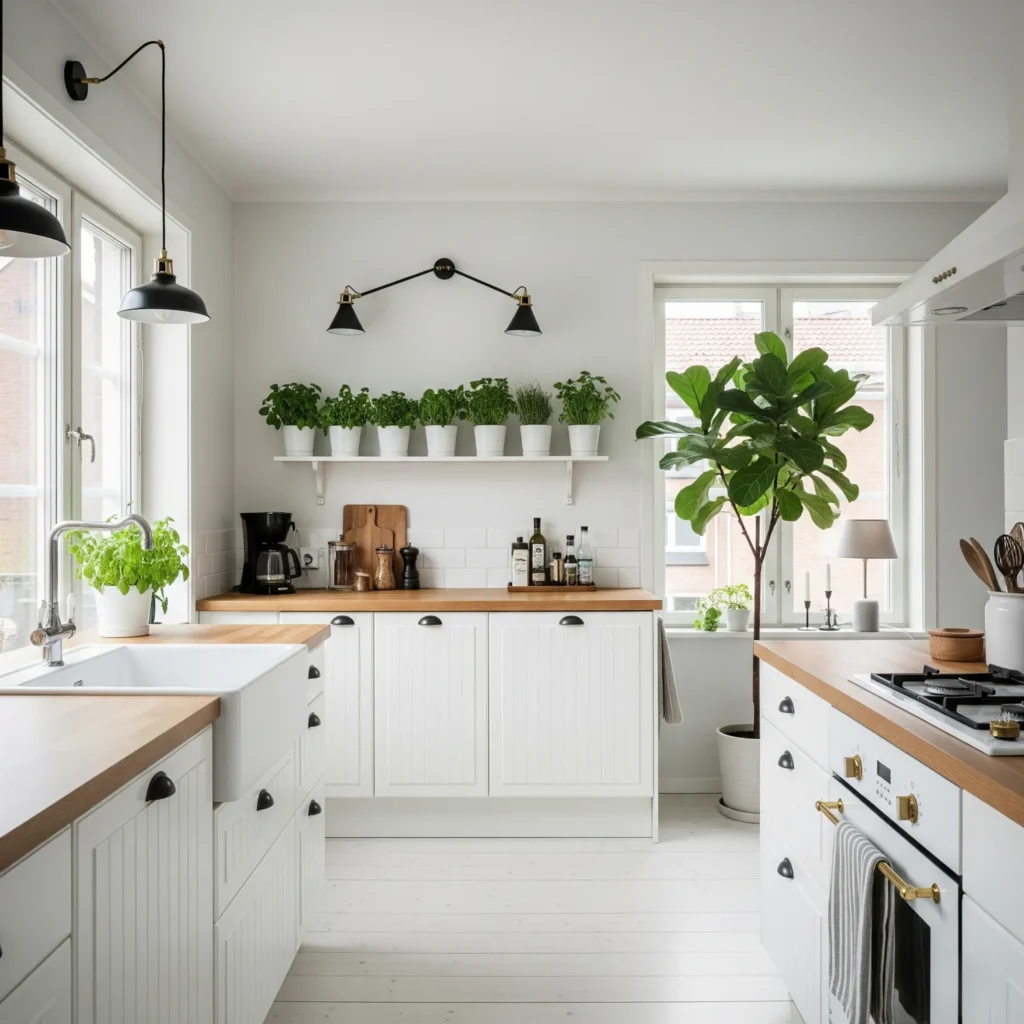
This Scandinavian kitchen masterfully balances minimalism with natural warmth. The design embraces the Nordic principles of simplicity and functionality while incorporating living elements that bring the space to life. Clean lines and a neutral color palette create a serene cooking environment that feels both spacious and intimate.
The dedicated herb shelf introduces both practical and aesthetic value. Fresh basil, parsley, mint, and other culinary herbs are easily accessible for cooking while contributing vibrant color to the primarily white space. This living pantry of flavors encourages healthier eating and more creative meal preparation.
The statement fiddle leaf fig anchors the room, providing vertical interest and a refreshing pop of green that brightens the entire kitchen. This architectural plant not only serves as a natural air purifier but creates a visual connection to the outdoors, making the kitchen feel more like a peaceful sanctuary than a purely utilitarian space.
Warm wooden countertops provide essential contrast against white cabinetry, ensuring the kitchen feels inviting rather than stark. Natural accessories like wooden cutting boards and glass storage containers complete the look, reinforcing the organic theme while maintaining the clean aesthetic.
4. Vintage Cottage Kitchen With Wildflowers
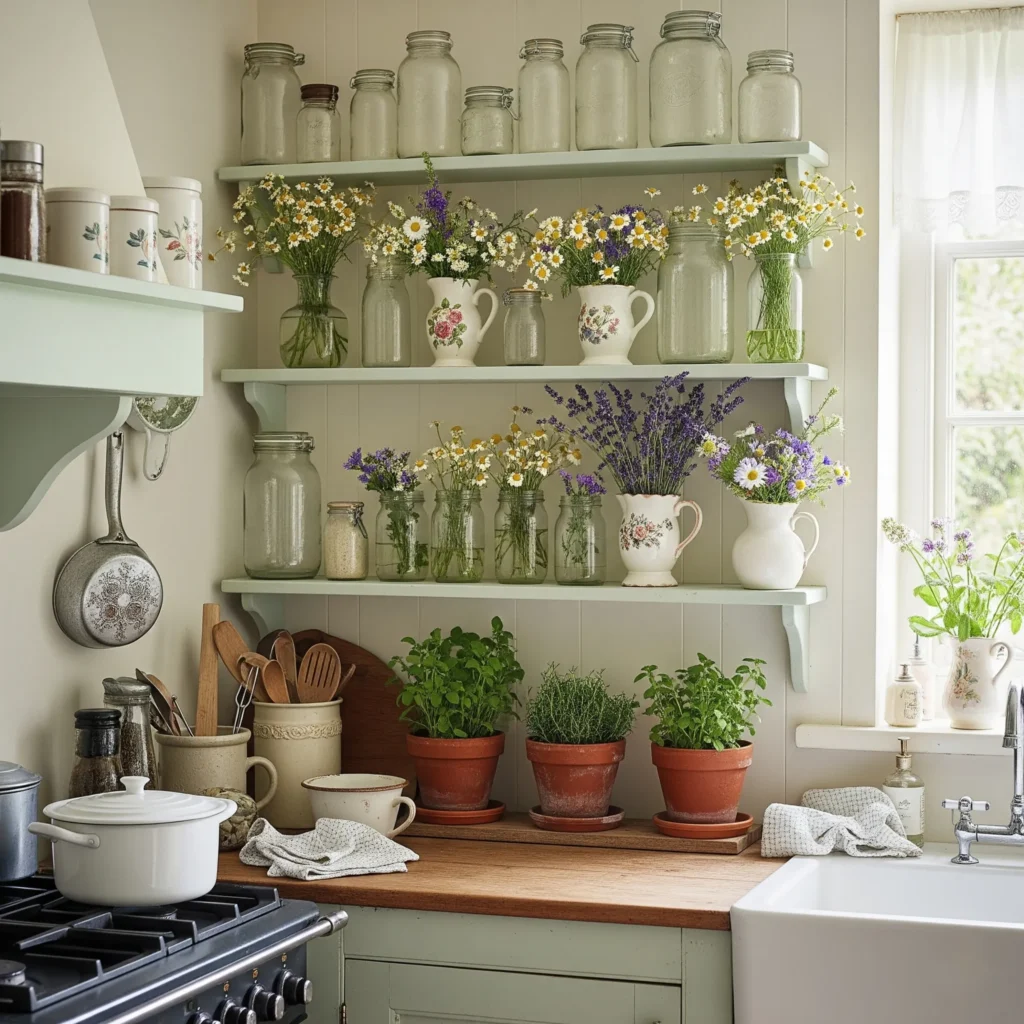
This enchanting vintage cottage kitchen captures the romantic essence of bringing the garden indoors. Open shelving displays an artful collection of jars and vases filled with freshly gathered wildflowers, introducing color, texture, and seasonal beauty to the cooking space.
Wildflowers such as daisies, lavender, and field blooms bring delicate fragrance and visual charm to everyday kitchen activities. The casual, collected-over-time arrangement creates an authentic, lived-in atmosphere that encourages creativity and slow living. Soft pastel walls and rustic wooden shelving provide the perfect backdrop for these natural elements, enhancing their impact without competing for attention.
Terracotta pots of fresh herbs on lower shelves combine beauty with practicality, keeping essential cooking ingredients within easy reach. Herbs like basil, parsley, and thyme not only serve culinary purposes but contribute to the kitchen’s cohesive garden aesthetic. This thoughtful design creates a meaningful connection to nature’s rhythms, transforming cooking from a chore into a mindful practice.
Whether baking heirloom recipes or preparing simple meals, this flower-filled kitchen reminds us to find joy in small pleasures and seasonal changes. It encourages a slower pace and deeper appreciation for natural beauty even during routine kitchen tasks.
5. Kitchen Window Garden Paradise
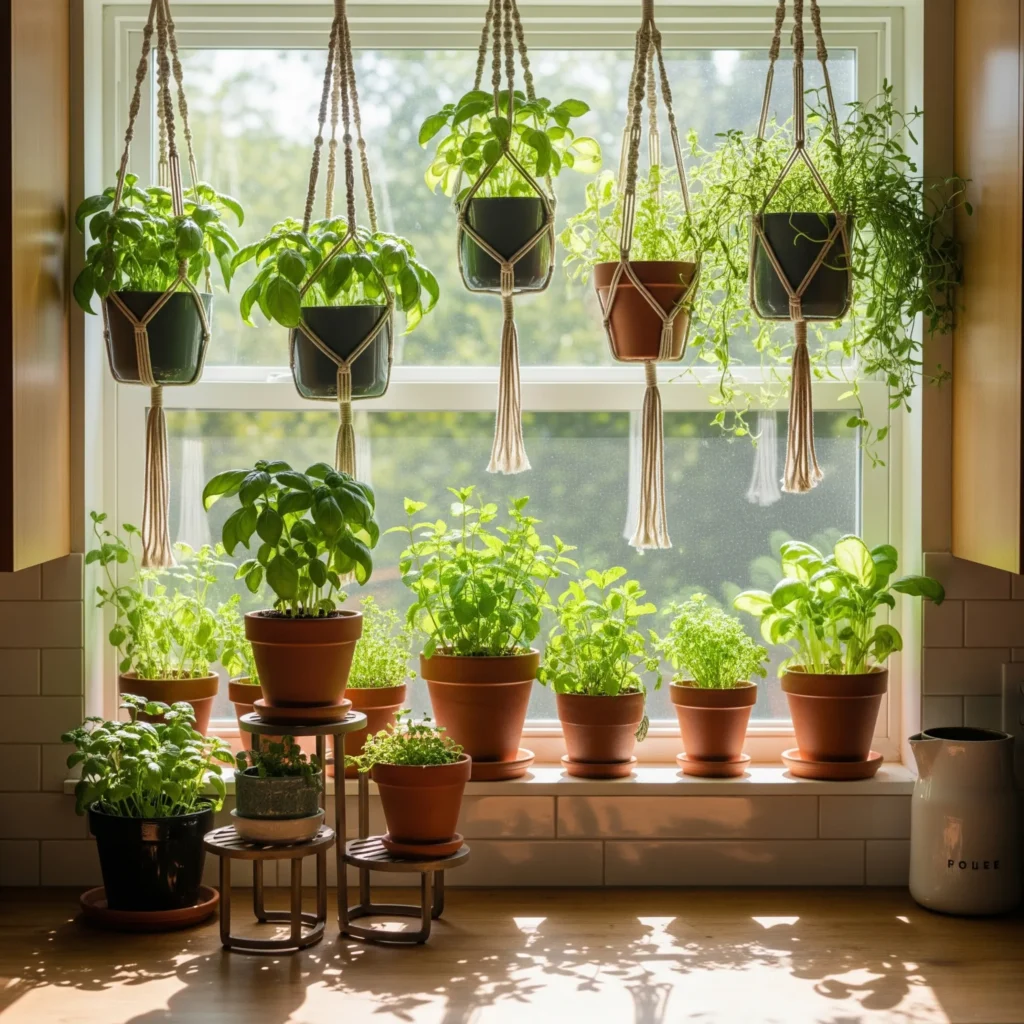
Transform your kitchen window into a verdant micro-garden that brings the outdoors inside year-round. This inspired arrangement showcases how hanging and potted plants can turn an ordinary window into an extraordinary natural feature that enhances both your cooking space and culinary creations.
Culinary herbs like basil, parsley, mint, and chives thrive in this sunny microclimate, providing fresh ingredients just inches from your prep area. Imagine the convenience of snipping aromatic herbs directly into your pasta sauce or muddling fresh mint for refreshing beverages without leaving your kitchen.
Beyond herbs, consider adding compact vegetables like lettuce, spinach, or microgreens to your window garden. These fast-growing edibles flourish in bright conditions and offer nutrient-dense additions to meals with minimal effort. The productivity of this small space is remarkable when designed thoughtfully.
Maintaining a window garden requires minimal effort for maximum reward. Regular watering and rotation to ensure even sun exposure are typically all that’s needed. The satisfaction of watching your plants develop—from tiny seedlings to harvestable ingredients—adds a rewarding dimension to kitchen time that connects you to natural cycles.
6. Small Space Kitchen With Vertical Plant Wall
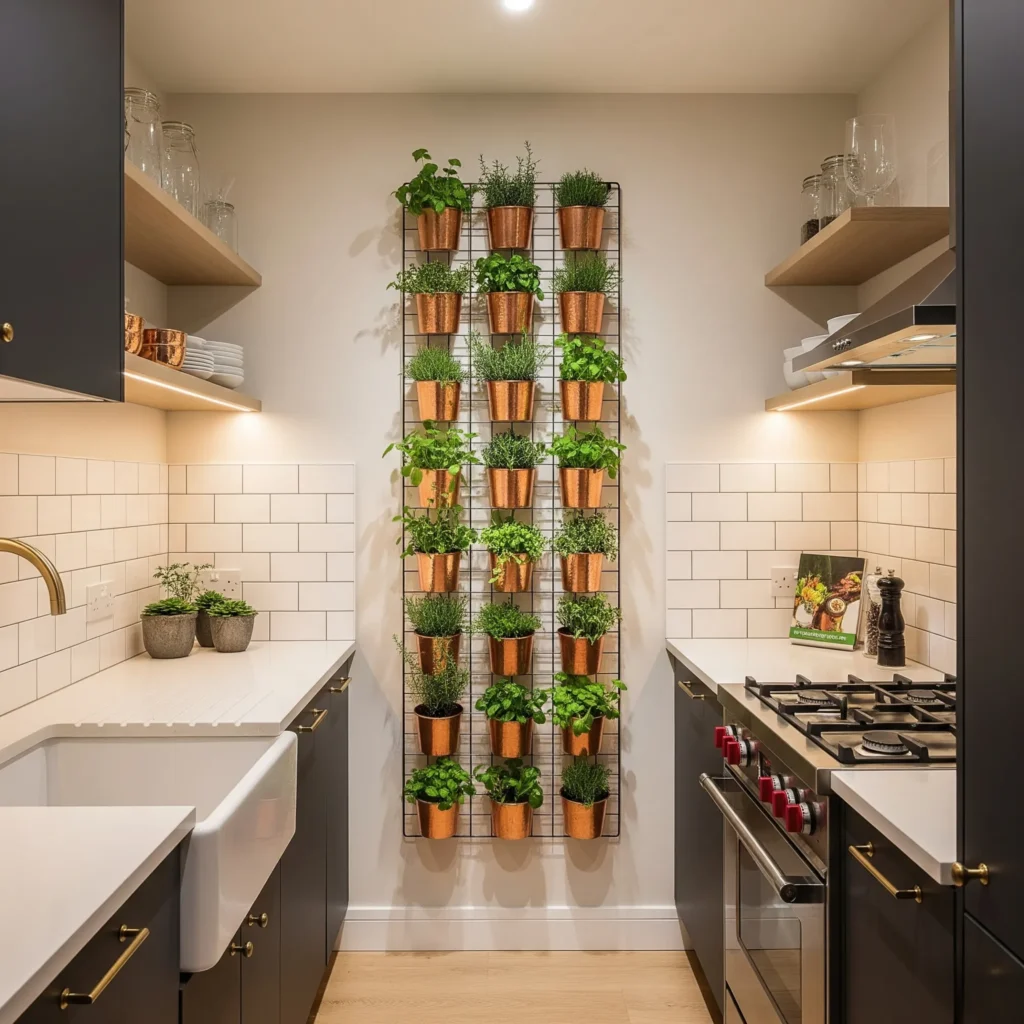
Space-challenged kitchens can still embrace abundant greenery through vertical gardening techniques. This ingenious design demonstrates how a plant wall maximizes visual impact while preserving precious floor and counter space in compact cooking areas.
The copper pots mounted on the wall create a striking metallic contrast against the verdant plants, adding warmth and character to the vertical garden. This material choice transforms utilitarian plant holders into design features that enhance the overall aesthetic. The varied selection of plants—from trailing varieties to compact specimens—creates visual rhythm and demonstrates how even the smallest kitchen can accommodate diverse greenery.
This approach delivers practical benefits beyond beauty. Properly selected plants improve air quality by filtering toxins and releasing oxygen, creating a healthier cooking environment. Herbs incorporated into the vertical arrangement remain accessible for cooking while occupying minimal space.
When designing your own vertical garden, carefully consider light conditions in your kitchen. Choose plants that will thrive in your specific environment—some varieties flourish in low light, while others require brighter conditions. This thoughtful planning ensures your living wall remains vibrant and sustainable as a permanent kitchen feature.
7. Rustic Kitchen With Fresh Green Touches

This charming rustic kitchen demonstrates how plant life enhances the inherent warmth of natural materials. The wooden shelving displays a thoughtful collection of terracotta pots housing various plants, creating a living gallery that adds dimension and vitality to the space.
Incorporating plants in a kitchen does more than please the eye—it actively improves indoor air quality and creates a more invigorating cooking environment. Culinary herbs strategically positioned near the prep area offer both visual appeal and practical convenience. Varieties like basil, mint, rosemary, and thyme not only look beautiful but provide fresh flavors that elevate everyday cooking.
The harmonious blend of deep sink, wooden cabinetry, and verdant plants creates a kitchen that feels grounded and authentic. This space transcends mere functionality to become a gathering place where cooking transforms into a joyful, sensory experience. The green elements soften the rustic materials, creating balance while maintaining the kitchen’s honest, unpretentious character.
8. Tropical Kitchen Retreat
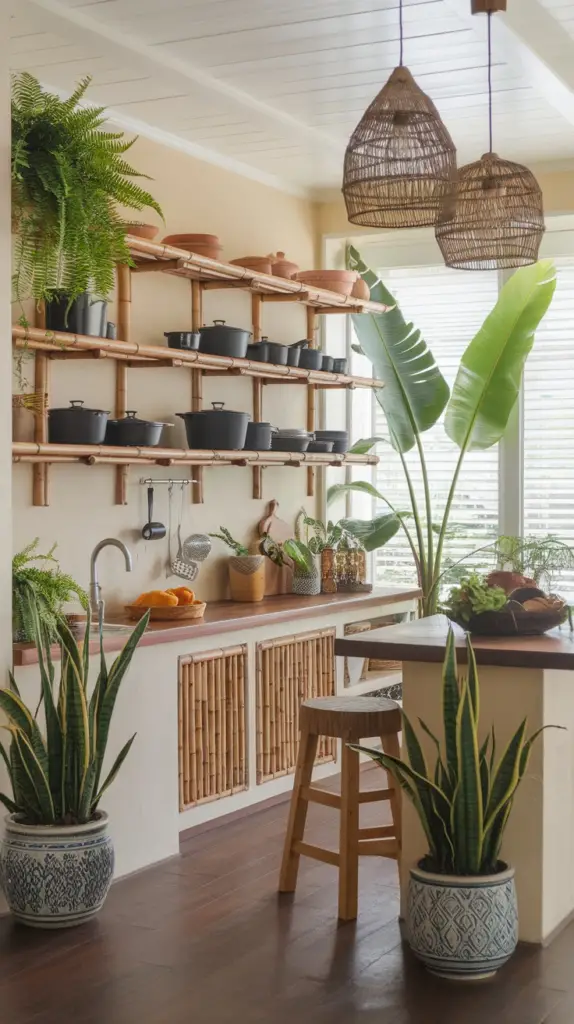
Transport yourself to an exotic paradise every time you prepare a meal in this tropical-inspired kitchen. The bamboo open shelving introduces natural texture and visual warmth while providing the perfect display opportunity for well-loved cookware and decorative items. Dappled sunlight streams through windows, enhancing the earthy tones of wooden surfaces and illuminating the vibrant greens of strategically placed plants.
Architectural specimens like the striking snake plant serve as natural sculptures that draw the eye while purifying indoor air. These hard-working plants remove toxins and release oxygen, improving your kitchen’s atmosphere literally and figuratively. For those seeking kitchen ideas using plants, this approach demonstrates how to create a cohesive theme that feels transported from a luxury resort.
Don’t overlook the impact of smaller botanical elements, such as the delicate ferns and culinary herbs incorporated throughout the counter space. These accessible plants serve dual purposes—enhancing aesthetic appeal while providing fresh ingredients for cooking. Imagine harvesting aromatic herbs moments before they’re needed in recipes!
The woven pendant lighting completes this tropical sanctuary, adding textural interest and casting a warm, ambient glow that enhances evening cooking sessions. These natural fiber fixtures complement the organic elements throughout the kitchen, creating a cohesive design that feels thoughtfully curated yet effortlessly relaxed.
9. French Country Kitchen With A Touch Of Green
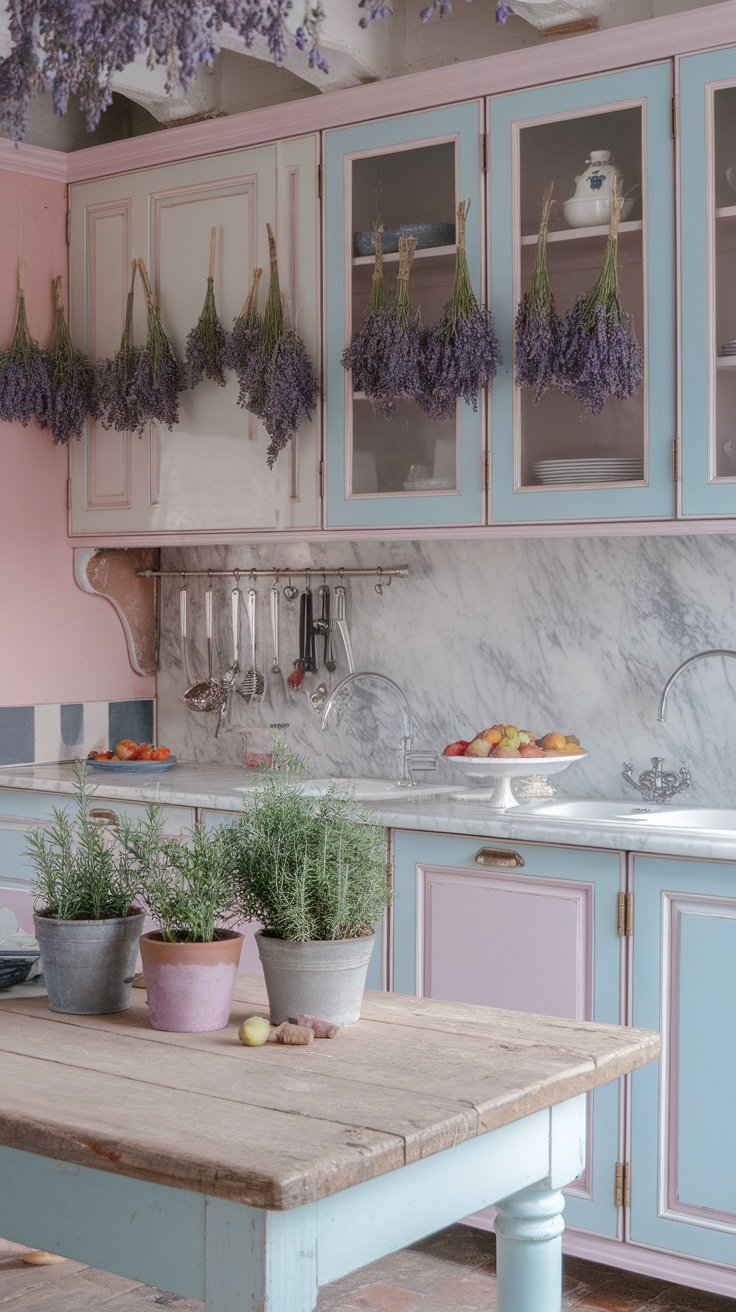
This kitchen embodies the timeless charm of French provincial style enhanced by thoughtful botanical elements. The soft pastel cabinetry in gentle blue and pink hues creates a romantic backdrop for the natural elements throughout the space. Bunches of fragrant lavender suspended from cabinetry introduce authentic French countryside character while filling the kitchen with soothing botanical aroma.
The central island features a collection of potted herbs that serve both decorative and practical purposes—enhancing the visual composition while remaining accessible for cooking. Fresh rosemary, thyme, and other culinary herbs add texture and fragrance while connecting the kitchen to French culinary traditions. The rustic wooden table introduces organic warmth that balances beautifully with the refined marble backsplash, creating layers of texture and visual interest.
A vibrant fruit display at the center anchors the space with natural color and reinforces the kitchen’s connection to fresh, seasonal ingredients. This thoughtfully composed kitchen demonstrates how plants and fresh produce can transform functional spaces into living environments that stimulate all senses. The integration of greenery makes the kitchen feel dynamic and connected to nature’s rhythms, inviting creativity and shared moments around food preparation.
10. Bright & Airy Kitchen With Hanging Herb Rack
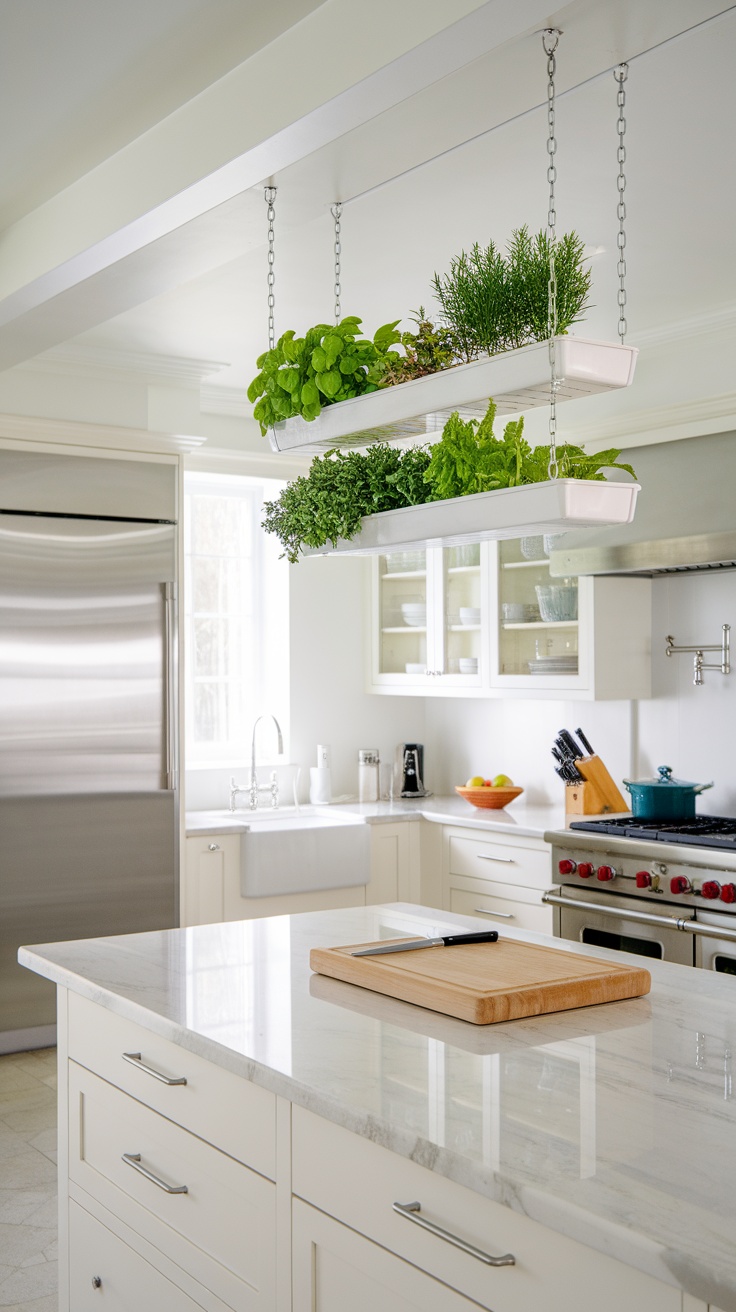
This ingenious kitchen design maximizes functionality and beauty through an innovative hanging herb rack positioned above the central island. This suspended garden showcases a variety of culinary herbs and leafy greens, creating a living canopy that draws the eye upward and adds vertical interest to the space. The arrangement allows plants to receive optimal light while keeping precious counter space free for meal preparation.
Abundant natural light floods the kitchen, creating ideal growing conditions for the hanging herbs while illuminating the entire space with cheerful brightness. This favorable environment ensures that plants like basil, rosemary, and even compact vegetables remain healthy and productive year-round.
The pristine white cabinetry and polished countertops create a clean backdrop that allows the vibrant greenery to stand out as the kitchen’s defining feature. This thoughtful contrast ensures the space feels balanced rather than cluttered, despite the abundance of plants.
This arrangement offers unparalleled convenience for cooking enthusiasts—fresh herbs can be harvested exactly when needed, enhancing flavors while eliminating waste. The proximity to the cooking area means that even in the midst of preparation, fresh ingredients remain within easy reach. This blend of functionality and beauty exemplifies how thoughtful kitchen design can elevate everyday cooking from routine to inspiration.
11. Compact Apartment Kitchen With Plants
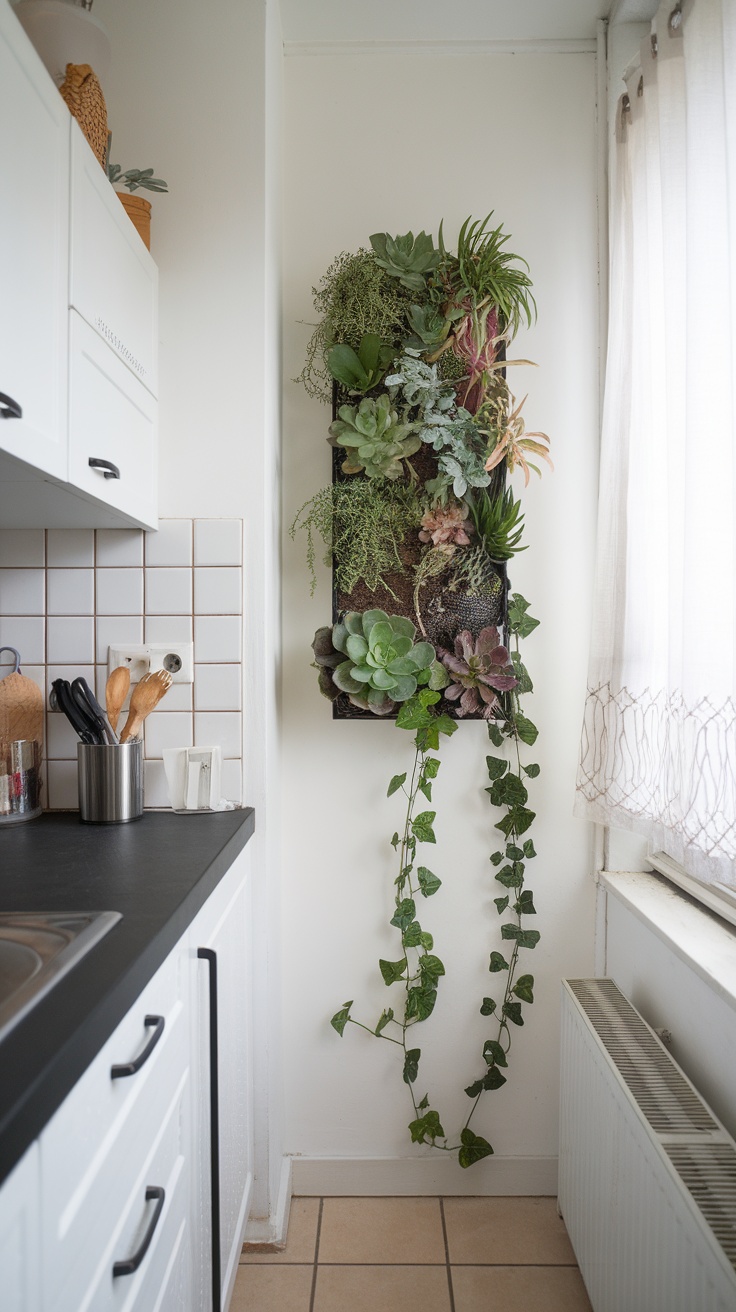
This clever kitchen design proves that limited square footage needn’t limit your connection to nature. The vertical garden installation maximizes wall space that would otherwise go unused, creating a living tapestry that transforms the compact kitchen into a vibrant oasis. This approach demonstrates how even the smallest cooking spaces can incorporate significant plant life through creative thinking.
The diverse collection of succulents and trailing vines introduces varied textures and shades of green, adding visual interest without overwhelming the small space. These low-maintenance plant selections thrive in kitchen conditions while purifying the air—an especially valuable benefit in smaller apartments where air circulation may be limited.
Strategic positioning near a natural light source ensures plant health while creating beautiful interplay between sunlight and foliage throughout the day. The warm glow highlighting the greenery makes the space feel more expansive and connected to the outdoors, counteracting the enclosed feeling common in apartment kitchens.
For those inspired to create a similar environment, begin with resilient, adaptable plants like pothos, spider plants, or compact herbs. These varieties forgive occasional neglect while adding life to your kitchen. With thoughtful vertical installation, your compact kitchen can become a refreshing green sanctuary that elevates daily cooking routines.
12. Open-Shelf Kitchen With A Plant Display

Open shelving transforms from mere storage solution to living display opportunity in this inspired kitchen design. The beautifully arranged collection of plants in varied containers—from earthy terracotta to refined ceramics—creates visual rhythm and interest across the shelving system. This approach merges functionality with natural beauty, turning everyday storage into an opportunity for botanical artistry.
Practical herbs and decorative specimens coexist harmoniously, creating a balanced composition that enhances the kitchen’s overall aesthetic. Imagine the pleasure of reaching for fresh mint or basil while cooking, harvesting exactly what you need from your living pantry. The soft greens and varied textures of the plants contrast beautifully with the wooden shelving and crisp white cabinetry, adding warmth and dimension to the space.
To recreate this appealing look, experiment with container heights, plant varieties, and positioning to create visual movement across your shelves. Incorporate both trailing and upright specimens for textural contrast, and leave breathing room between groupings to prevent a cluttered appearance. Include practical kitchen items like wooden cutting boards or ceramic serving pieces alongside your plants to maintain functionality while enhancing the natural theme.
13. Mediterranean Kitchen With Olive Trees
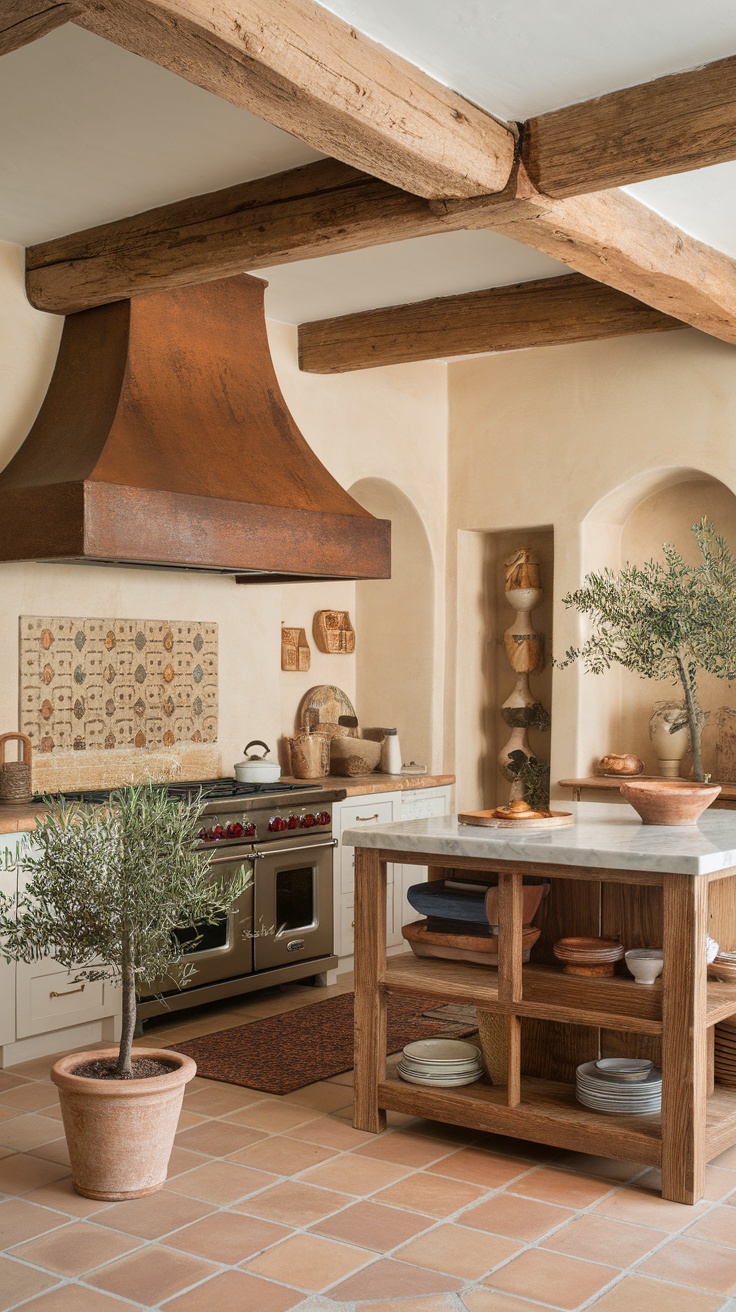
This captivating Mediterranean-inspired kitchen celebrates the region’s connection to olive cultivation through thoughtfully incorporated olive trees. These symbolic plants introduce authentic character and old-world charm to the contemporary cooking space, creating a sense of history and tradition that enhances everyday culinary activities.
The warm earth tones of terracotta tiles and exposed wooden beams create a rustic envelope that perfectly showcases the silvery-green foliage of the olive trees. This color palette evokes sun-baked Mediterranean landscapes, transporting you to coastal Italian or Greek kitchens where fresh ingredients and simple preparation honor natural flavors.
The professional-grade range and distinctive hood establish cooking as the central activity in this space, while the olive trees add living beauty that softens the kitchen’s functional elements. These resilient trees thrive indoors with adequate sunlight and minimal care, making them excellent choices for adding Mediterranean flair without excessive maintenance requirements.
Practical considerations merge seamlessly with aesthetics throughout this kitchen. The open shelving provides easy access to everyday items, while the durable marble countertop creates an ideal workspace for meal preparation. The addition of olive trees transforms what could be an ordinary kitchen into an extraordinary space that celebrates the Mediterranean’s rich culinary heritage.
14. All-White Kitchen With A Botanical Pop
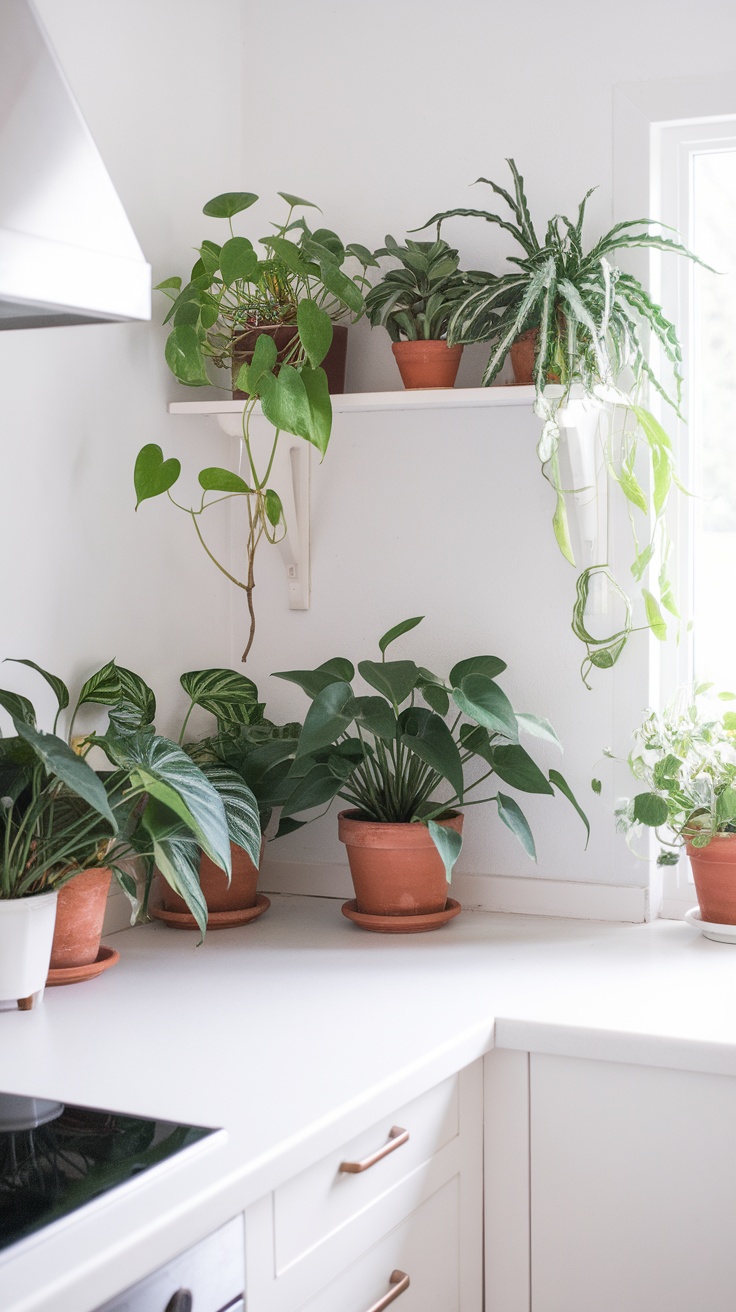
This pristine kitchen demonstrates how botanical elements can transform a monochromatic space into a dynamic, inviting environment. The clean white backdrop—from cabinetry to countertops—creates a gallery-like setting that allows plant life to take center stage. The reflective surfaces amplify natural light, creating ideal growing conditions while making the kitchen feel expansive and airy.
Strategically placed plants introduce vibrant color and organic texture that prevent the all-white palette from feeling clinical or stark. The contrast between structured architectural elements and the free-flowing forms of the greenery creates visual tension that enhances both components. Earthy container choices in terracotta and natural materials add warmth and grounding elements to the bright space.
From low-maintenance varieties like pothos to more specialized specimens, plants selected for this kitchen improve air quality while creating a more peaceful atmosphere for cooking and gathering. The window-adjacent positioning ensures optimal light exposure while connecting the interior space to outdoor views.
Consider incorporating culinary herbs like basil or rosemary into a similar arrangement to combine beauty with functionality. These additions enhance both the kitchen’s appearance and your cooking, demonstrating how thoughtful plant selection can serve multiple purposes in well-designed spaces.
15. Glasshouse Kitchen With A View
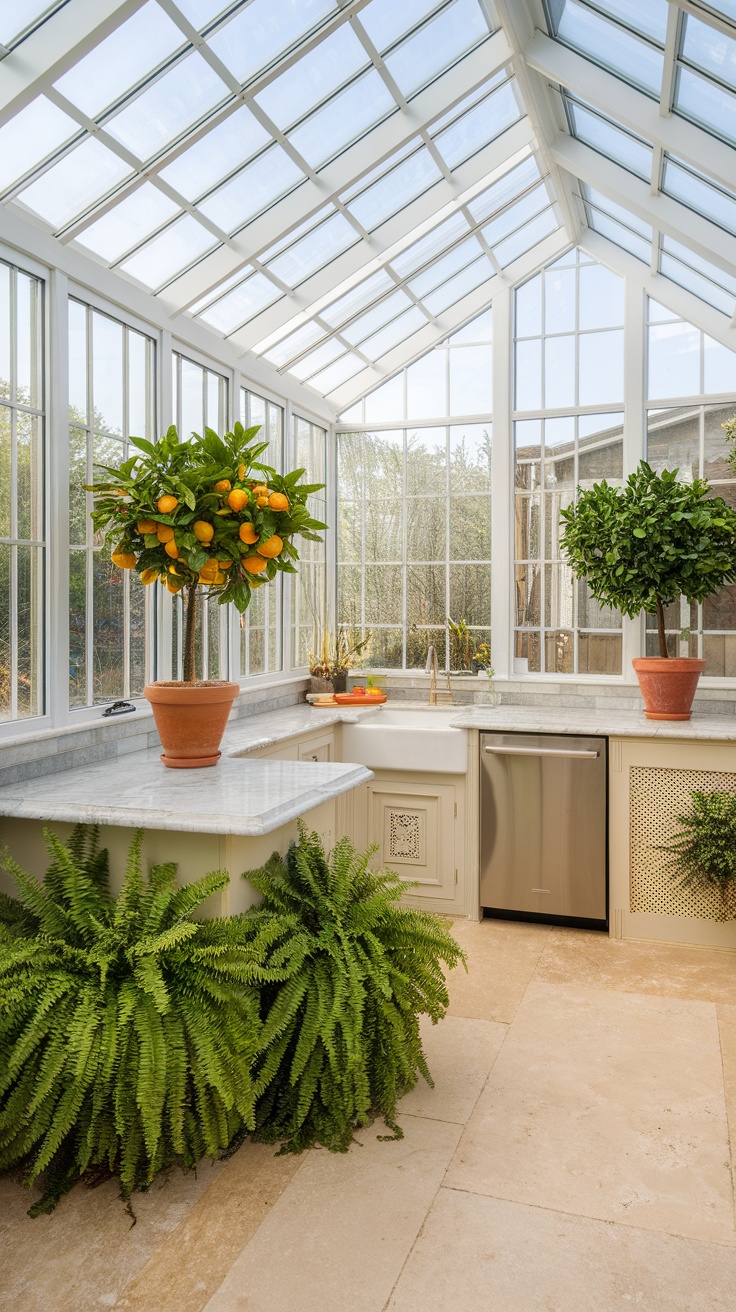
This extraordinary kitchen blurs the boundary between indoor and outdoor living, creating a cooking environment that feels connected to nature in every direction. The glass walls flood the space with natural light, creating ideal conditions for plants to thrive while offering spectacular views that change with the seasons.
Potted citrus trees heavy with colorful fruit serve as living sculptures throughout the space, adding height variation and vibrant color. These productive plants offer more than beauty—they provide fresh citrus that can be harvested directly during meal preparation. Imagine plucking a lemon for seafood dishes or an orange to brighten a salad, creating a true garden-to-table experience.
Lush ferns nestled around the base of counters create a layered effect that softens the kitchen’s architectural lines. These air-purifying plants actively improve the cooking environment while adding textural contrast to the sleek surfaces. The combination of abundant greenery and sunlight creates a space that feels refreshing and energizing—perfect for inspired cooking sessions.
This glasshouse concept demonstrates the transformative power of integrating nature into kitchen design. Whether you have a fully glass-walled space or simply a kitchen with good natural light, incorporating plants at various heights creates a dynamic environment that connects daily cooking activities to the natural world in meaningful ways.
Which of these natural kitchen designs speaks to you? Whether you have a sprawling space or a compact cooking area, incorporating plants brings life, color, and functionality to the heart of your home. Start small with a few herbs on your windowsill, or go bold with statement greenery—either way, your kitchen will thank you for the natural touch.

